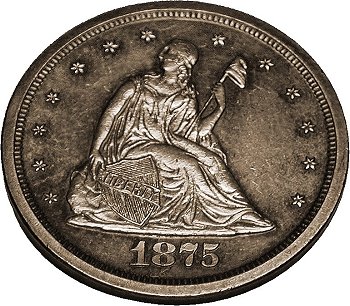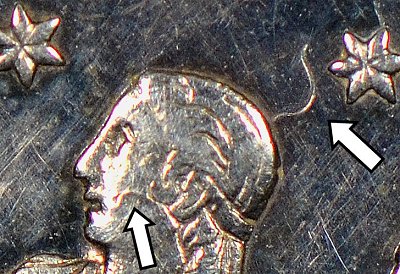1875-S Branch Mint Proof
Other general diagnostics
All 1875-S branch mint proofs will have the above diagnostics. For a coin to be considered a branch mint proof, it must have other characteristics of a proof issue.
Therefore, further investigation is needed to determine whether a particular coin is a proof or a coin struck for circulation.
Detail
The 1875-S branch mint proofs have a level of detail from the striking process that is not present on circulation strikes, even if the circulation coins are well-struck. In addition to highly reflective fields, key places to look are the high points of the coin:
- The letters of LIBERTY on the shield will be extremely well struck-up and have the appearance of being squared
- Liberty’s head will have a strong level of detail in the hair and facial features
- The eagle’s central breast feathers, neck, and wings will show extraordinary detail, even on the highest points.
Some weakness will be found on the denticles on the lower reverse. This is expected and not due to strike. It is a result of the excessive die polishing that
occurred before the dies were used to strike the coins.


Three-dimensionality and exceptional details
Other artifacts not present on circulation strikes, but found on proofs or specimen strikes include:
Border and Edge
The 1875-S proofs will have a border that is wider than a typical circulation strike. A branch mint proof will also have a squared edge and distinctly separated denticles. The rims may
also have a raised line along the edge, referred to as a wire rim.
Many well-struck circulation strikes, including those struck by the proof dies, have a partial wire or raised rim. On circulation strikes, however, the rim on the opposite side will be
rounded or beveled. This would support the coin as a circulation strike.
Dished or concave-looking fields
Because of the way these proof coins were struck, the fields surrounding the devices near the rims will appear to be concave. This concavity also enhances the appearance of the mirrored fields.


Planchet Preparation Lines
These lines occur when the blank planchet has been burnished or polished before striking. Planchet striations are not always visible on branch mint proofs due to improper handling or cleaning
of the coins, however.
Lines on a coin resulting from planchet preparation are different from those resulting from die polishing. Polishing the die leaves shallow scratches in the die’s fields which result in raised
lines on the struck coin. Planchet preparation is the polishing of the planchet prior to striking, leaving striations on the unstruck planchet. The planchet is then struck with the dies and
the striations are flattened as a result of the striking. As such, the striations have no relief. These striation lines can also appear to extend into the devices. Although difficult to see,
the presence of these striation lines support the coin being a proof or specimen strike. Planchet preparation lines are not found on circulation strikes as the planchets used for those coins
were not polished before coining.
Interestingly, many of the 1875-S branch mint proofs have an obverse with deeper mirrors than the reverse. This is likely due to the obverse side of the planchet receiving more attention during
preparation than the reverse and that the planchets were then placed with a specific orientation during striking.
The horizontal pattern in the picture below and left are the parallel polishing lines from when the planchet was polished before striking.
Lint Marks
When a die is polished in the process of making proofs, often a piece of lint from the polishing cloth is left behind on the die. When a die with lint adhered to it strikes a planchet, the coin is struck through the lint and there will be an incuse mark showing where the lint fiber was during striking. This is referred to as a lint mark.


Lint marks are fairly common with proofs, but not so with circulation strikes. The two finest known 1875-S branch mint proofs (possibly the first two struck) have multiple lint marks.
As more proofs were struck, the number of lint marks decreased until there were none, as seen on some specimens.
The presence of a lint mark supports a coin’s proof or specimen status, but is not conclusive evidence.
The Proof Dies used for Circulation Strikes
The same pair of dies used to strike the 1875-S branch mint proofs were also used to coin circulation strikes. Circulation strikes from this die marriage can be found with modest effort.
Some of the coins are very well struck with a partial wire rim. These circulation strikes, however, do not have the depth of strike or reflective fields found on the proofs, nor do they
have the attributes described above.
Controversy
There are some collectors who doubt the existence of 1875-S branch mint proofs. However, examination of the finest known examples of the 1875-S branch mint proofs clearly yields coins that
are special and of far superior quality to pieces struck for circulation, and on par with Philadelphia proofs. Even with the branch mint proofs of lesser quality, comparison against proof-like
circulation strikes still results in a clear distinction. The branch mint proofs are the result of a special striking. However, without official records or other forms of contemporary
verification, some choose to refer to these coins as specimen strikes and others prefer to call them nothing special at all.
The authors believe that the branch mint proof coins were special coins struck to commemorate the new denomination and provided to dignitaries or other guests of importance. Following the
special striking, the dies were tendered for service making normal circulation strikes. The question is when did the proof striking end and the circulation striking begin? It is an impossible
question to answer as no official records are known. It remains a decision based on the coin and it’s similarity to an actual proof coin.
Values
There are currently only 4 coins that have been certified and graded as branch mint proofs by the two major grading services. However, it is unknown whether these 4 coins represent unique pieces
or are duplicate submissions to the grading companies. Of the two finest known examples, records show the Proof-63 selling privately in 1995 for $65,000 and the Proof-64 Cameo selling at auction
in 2004 for over $100,000.
For the rest of the branch mint proofs the sale prices are not nearly as high. Most of the rest of the known examples are impaired and often unattractive. These impaired examples have sold in
the modest range of $4,000-7,000. The plate coin in this book is one such coin that was mishandled and lightly cleaned many years ago, but has naturally re-toned over many decades with an
attractive, original-looking skin.
Another factor is that the issue is so rare as to be nearly unobtainable, and a collector can still have a “complete set” without one, lowering demand significantly. The relatively modest value
of impaired branch mint proofs is also due in part to the controversy surrounding this issue and the reluctance of collectors to pay large premiums for coins that are not universally accepted.
Still, it is hard to predict what one of these is worth today, either impaired or not, as each example is different, and eye appeal is paramount.
1875-S BMP Obverse |
1875-S BMP Reverse |
 Click for full-size image |
 Click for full-size image |
